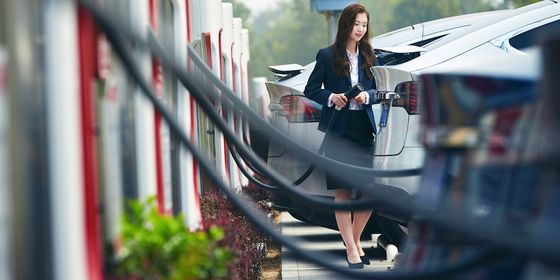China’s Hyperloop, drones that look like doves, and the social credit system spreading overseas. The future is today—it’s Tech Thursday
Each Thursday, The World of Chinese takes the most ground-breaking, impressive, or just plain weird technological advancements related to the Middle Kingdom and serves them in bite-sized chunks to keep you up-to-date on the latest news in the world of Chinese technology.
China’s Hyperloop
Recent updates in state media concerning plans to pilot a high-speed magnetic levitation (maglev) train has renewed talk about “China’s Hyperloop”—a reference to billionaire Elon Musk’s long-touted plans to pioneer a “flying train” in a vacuum tunnel that might eventually be capable of top speeds of up to 2,485 miles per hour (four times the speed of commercial flights; three times the speed of sound), potentially revolutionizing travel, work and society as we know it.
According to the Global Times, Southwest Jiaotong University in Sichuan’s Chengdu “is developing a railway test platform that would allow trains to travel as fast as 1,500 kilometers an hour [and] tests are expected to begin in April 2021 after the initial construction.”
“Musk was playing down China’s high speed railway by bringing up the concept of a super high-speed railway capable of running up to 1,200 kilometers an hour,” a hyper-sensitive expert rather bizarrely claimed to the paper (Musk made no mention of China when he mooted the plan in 2013). “China has now answered the call by announcing one capable of 1,500.”
Meanwhile, a more modest project is testing maglev models expected to reach 400 km/h, and being built separately in Chengdu, said a Science and Technology Daily report—although China’s current HSR system may already be technically capable of speeds of 380 km/h (Hyperloop tests currently clock in at 387 km/h).
Previous testing in the US and Europe has seen speeds reached of between 310-323 km/h, but in August the state-run space contractor, China Aerospace Science and Industry Corporation (CASIC), claimed that its closed-tube system (which, it added, has over 200 patents) will initially aim for 1,000 km/h. Experts point out that, with each mile of required pipeline costing around 150 million USD to build, the first functional Western line will not be around until, at the very least, 2020, and ticket prices are still a major concern (those wishing to commute between cities will likely pay premium rates, while off-peak journeys at 3am may be more affordable—just).
But China doesn’t have to worry about land rights, eminent domain, environmental protestors, or local laws, regulations and general pushback. CASIC has breathlessly suggested its “Hyperloop” could even become part of Beijing’s One Belt, One Road—but probably best not to hold your breath just yet.
It’s a bird, it’s a plane, it’s a drone!
The latest surveillance drones from China resemble birds. Each drone is equipped with sophisticated GPS system with a digital camera and flight control system connected via satellites for remote control, plus a small electric motor to flap its wings. “Currently, the scale is still small, whereas it will be applied to both the civilian and the military sectors in the near future,” said Yang Wenqing, an associate professor at the university’s School of Aeronautics.
BYD unveils largest battery plant in the world
China’s leading clean-energy vehicle producer, Build Your Dreams (BYD) has unveiled a new battery production plant that claims to be the largest of its kind in the world. The plant, which will churn out units for electric vehicles, will be at full capacity by 2019, is equipped with nearly 100 robots, and is designed to have 24GWh production capacity annually.
“The new energy automobile industry is expected to pick up more substantially as the he governments the world over has issued a timeline to ban traditional fuel vehicles,” said chairman of Shenzhen-based BYD Wang Chuanfu. The plant is expected to meet rising global demands and help ease a shortage in high-tech battery production.
Social Credit spreading wings overseas
Concerns about China’s big-data system for rating citizen behaviour are being raised once more by a report which suggests the social credit system (SCS) may soon be applied to overseas Chinese, is already been deployed to keep foreign companies in line, and could possibly even “interfere directly in the sovereignty of other nations.” All companies in China must now comply with licencing requirements and register for an 18-digit “unified social credit code,” which they must register in order to do business. Violations are recorded on the National Enterprise Credit Information Publicity System (which is, despite the name, not made public) and there are questions about how this confidential information could be used to coerce these corporations overseas.
Researcher Rogier Creemers has advised that SCS is, in fact, still in its infancy and best viewed as “an ecosystem of initiatives broadly sharing a similar underlying logic, than a fully unified and integrated machine for social control.” Security think tank the Australian Strategic Policy Institute’s report also falls short of making direct accusations. Yet it is sure to provide grist to lawmakers in countries like Australia and the US, where both governments have growing bipartisan support to resist (or “contain,” depending on your point of view) “covert, coercive or corrupt foreign interference. But there are also concerns in Beijing, where some worry that a recently strident tone and various “overconfident” boasts may have ignited a premature showdown between geopolitical powers. The freakiest part for peaceniks? Their main worry is that it’s “premature.”










